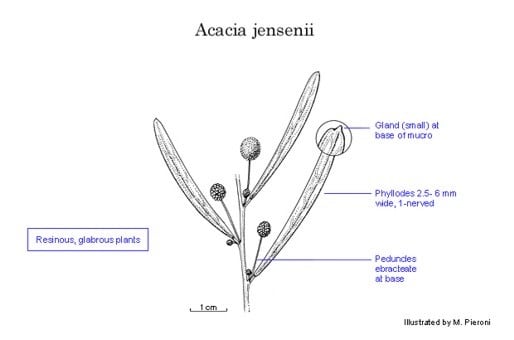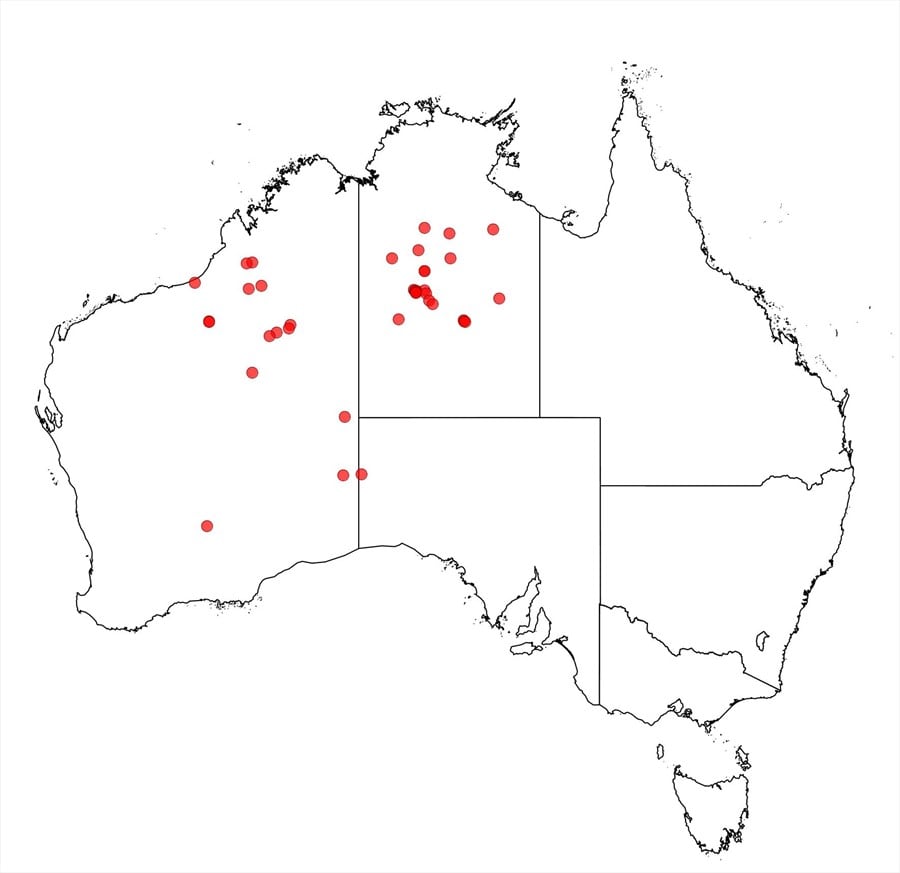Acacia jensenii Maiden
WATTLE
Acacias of Australia
Common Name
Spear Wattle, Mulyati
Family
Fabaceae
Distribution
Scattered and infrequent in the north-western and central arid zone, W.A., and at Lake Surprise, Tanami Desert, N.T. Also in the Edgar Ra., southern Kimberley, W.A.
Description
Spindly, open shrub or tree 2–6 m high, with one or two slender main stems from the base, glabrous, resinous. Closely related to A. dictyophleba and A. sabulosa but distinguished in the following ways: Phyllodes linear to linear-oblanceolate or narrowly elliptic, 2.5–6 cm long, 3–6 mm wide, l:w = 7–13, prominently 1-nerved per face, occasionally with an imperfect longitudinal nerve parallel to midrib; lateral nerves longitudinally anastomosing and normally not overly prominent; basal gland oblong, infrequently linear, 0.5–1 mm long, 0–3 mm above pulvinus. Mature pods and seeds not seen, but immature pods 7–8 mm wide and probably with oblique seeds.
Habitat
At Lake Surprise, N.T., this species grows on the upper slopes and crests of sand dunes, while in the Edgar Ra., W.A., it occurs in sandstone gullies.
Specimens
W.A.: c. 17 km (by track) SW of Well 35, Canning Stock Route, A.S.George 15654 (BRI, DNA, PERTH); Edgar Ra., K.F.Kenneally 5630 (PERTH, TLF). N.T.: Lake Surprise, Lander R., J.R.Maconochie 1689 (DNA, NSW, PERTH).
Notes
Used for spears by Aborigines.
Along with A. melleodora and A. sabulosa this species may possibly be better treated as an infraspecific taxon of A. dictyophleba. However, the absence of mature pods and limited habit/habitat details make it difficult to accurately assess its status. Most reliably distinguished from A. dictyophleba and A. melleodora by its narrow, usually linear and 1-nerved phyllodes. The spindly open habit of A. jensenii helps to further distinguish the species from its relatives, but a variant of A. dictyophleba with similar growth characteristics is discussed under that species. Phyllodes superficially similar to A. orthotropica from Kimberley region, W.A., but the two species probably not especially closely related.
FOA Reference
Data derived from Flora of Australia Volumes 11A (2001), 11B (2001) and 12 (1998), products of ABRS, ©Commonwealth of Australia
Author
B.R.Maslin
Minor edits by J.Rogers
This identification key and fact sheets are available as a mobile application:
URL: https://apps.lucidcentral.org/wattle/
© Copyright 2018. All rights reserved.







